Salt-assisted synthesis of transition metal-based catalysts: Basic principles, recent progress in the synthetic strategy and multifunctional applications
IF 20.3
1区 化学
Q1 CHEMISTRY, INORGANIC & NUCLEAR
引用次数: 0
Abstract
Transition metal-based catalysts have broad application prospects in the fields of energy and environmental science. The synthesis process with “green” and “economy” fashion, and the potential to amplify production has been pursued to meet the practical application. Common salts (NaCl and KCl etc.) are abundant in nature with good chemical stability. The salts can act as “spacers” in the solid-based salt-template method (STM) and act as liquid medium in molten salt method (MSM) to realize the designed synthesis of transition metals (TMs: Co, Mo, Ni, Fe, etc.)-based materials via special interaction of salts with reactants. The special crystal structure of the salts can induce the growth of the materials/intermediates with specific structure, realizing the better control during the synthesis. The strong polarizing force from molten salt greatly promotes the dissolution of the reactants. The liquid environment and spatial confinement effect of molten salt can make the high dispersion of the reaction process and materials. These interactions between salts and reactants are favorable to design the materials with well-defined morphology/property and enhanced performance. The (quasi) solid-based synthesis process endows the potential for amplified produce and the characteristics of easy recycling of salts give the more cost-effective synthesis process. Here, this review focuses on salt-assisted synthesis of transition metals (TMs, Co, Mo, Ni, Fe)-based materials. First, we have given the basic principles in the salt-assisted synthesis (STM and MSM). The connection and difference between two routes are summarized with an emphasis on their unique properties and contributions to the synthesis of targeted materials. Then, the recent progress in the typical TM-based materials is introduced in detail. Thirdly, we list some promising applications of the materials from these routes. The challenges and outlooks are finally proposed. This review can provide a comprehensive insight on this promising system and a guide for design of the advanced energy catalysts.

盐辅助合成过渡金属基催化剂的基本原理、合成策略及多功能应用研究进展
过渡金属基催化剂在能源和环境科学领域有着广阔的应用前景。为了满足实际应用的需要,人们一直在追求 "绿色 "和 "经济 "的合成工艺,以及放大生产的潜力。常见的盐类(NaCl 和 KCl 等)在自然界中含量丰富,具有良好的化学稳定性。这些盐在固态盐模板法(STM)中可充当 "间隔物",在熔盐法(MSM)中可充当液体介质,通过盐与反应物的特殊相互作用,实现过渡金属(TMs:Co、Mo、Ni、Fe 等)基材料的设计合成。盐类的特殊晶体结构可诱导具有特定结构的材料/中间体生长,从而在合成过程中实现更好的控制。熔盐产生的强大极化力极大地促进了反应物的溶解。熔盐的液态环境和空间约束效应可使反应过程和材料高度分散。盐和反应物之间的这些相互作用有利于设计出具有明确形态/性能和更高性能的材料。基于(准)固体的合成工艺具有放大生产的潜力,而盐类易于回收利用的特点则使合成工艺更具成本效益。在此,本综述重点介绍盐辅助合成过渡金属(TMs、Co、Mo、Ni、Fe)基材料。首先,我们介绍了盐辅助合成(STM 和 MSM)的基本原理。总结了两种途径的联系和区别,重点介绍了它们的独特性质以及对目标材料合成的贡献。然后,详细介绍了基于 TM 的典型材料的最新进展。第三,我们列举了这些路线材料的一些有前途的应用。最后提出了面临的挑战和展望。这篇综述可为这一前景广阔的系统提供全面的见解,并为先进能源催化剂的设计提供指导。
本文章由计算机程序翻译,如有差异,请以英文原文为准。
求助全文
约1分钟内获得全文
求助全文
来源期刊

Coordination Chemistry Reviews
化学-无机化学与核化学
CiteScore
34.30
自引率
5.30%
发文量
457
审稿时长
54 days
期刊介绍:
Coordination Chemistry Reviews offers rapid publication of review articles on current and significant topics in coordination chemistry, encompassing organometallic, supramolecular, theoretical, and bioinorganic chemistry. It also covers catalysis, materials chemistry, and metal-organic frameworks from a coordination chemistry perspective. Reviews summarize recent developments or discuss specific techniques, welcoming contributions from both established and emerging researchers.
The journal releases special issues on timely subjects, including those featuring contributions from specific regions or conferences. Occasional full-length book articles are also featured. Additionally, special volumes cover annual reviews of main group chemistry, transition metal group chemistry, and organometallic chemistry. These comprehensive reviews are vital resources for those engaged in coordination chemistry, further establishing Coordination Chemistry Reviews as a hub for insightful surveys in inorganic and physical inorganic chemistry.
 求助内容:
求助内容: 应助结果提醒方式:
应助结果提醒方式:


